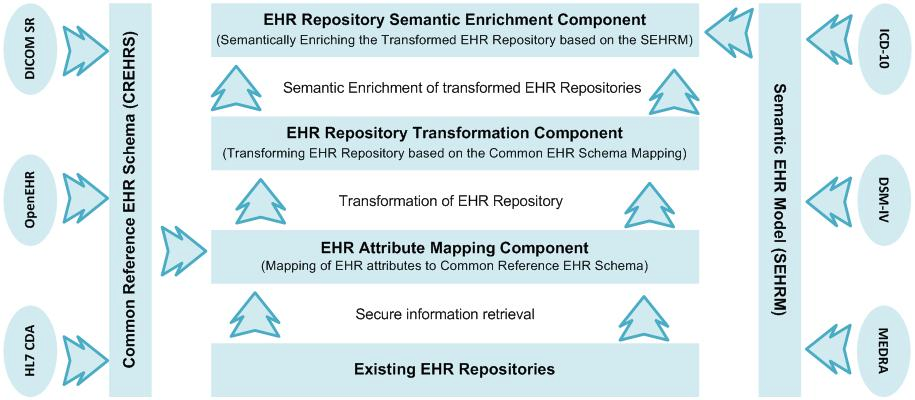ubi:EHRInteroperability Interoperability of Electronic Health Records
The central piece for healthcare and public health is information. Electronic Health Records (EHRs) contain an increasing wealth of medical information which has the potential to significantly advance medical research, personalized healthcare, as well as health policies formulation, providing society with additional benefits within a global health perspective, with applications ranging from disease prevention and genetics to surveillance and epidemiologic studies. Healthcare Organizations and the pharmaceutical industry in Europe both share a common goal, to deliver the best possible personalized treatments and innovative medicines to improve patient outcomes. The industry believes that technological advances and broad implementation of EHRs in Europe can achieve this goal and accelerate clinical research. However, the European healthcare information space is fragmented due to the lack of legal and technical standards, cost effective platforms, and sustainable business models. The potential gains in efficiency and effectiveness for primary care afforded by rapid and secure access to patient healthcare data in electronic form are widely recognized today across the EU. Common standards and interoperability will bring opportunities for a global approach for the benefit of patients, health systems and the market. Effective use of EHRs has the potential to positively influence both the quality and the cost of health care. Consequently, sharing patient’s EHRs is becoming a global priority in the healthcare information technology domain.
On top of that, the semantic approaches to promote interoperability among standard-compliant information systems, e.g. reference ontologies and mediation, have proven to be able to have significant potential as regards the integration of information from distributed EHR databases. The semantic Interoperability of patient data between EHRs and medical research can transform today’s process of drug discovery, development and commercialization, enable faster access for patients to effective new medications, provide improved patient outcomes, improve medication security and signal detection, and provide a key foundation for targeted (personalized) medicines.
ubi:EHRInteroperability takes advantage of recent innovations in the Semantic Web research, e.g. semantic interoperability efforts and Linked Data technologies, in order to deliver an extensible, scalable architecture that facilitates the semantic interlinking of electronic patients’ health records for gathering and sharing adequate knowledge to support decision making in medical and clinical research. These technologies are empowered by a common shared infrastructure (including ontologies and common medical vocabularies, mapping and alignment tools, for exposing, sharing, and connecting pieces of healthcare, medical and clinical data, information, and knowledge. The utilization and deployment of the aforementioned technologies for addressing semantic and technical interoperability of EHR repositories allows homogenized, standardized access to patients data and clinical information resources.
ubi:EHRInteroperability implements a toolset for the different medical and clinical data providers to align, map and transform their heterogeneous EHR repositories (with clinical and healthcare data) to a reference EHR Schema, while providing also the mechanisms for the semantic enrichment of the locally transformed and maintained EHR records with the globally available medical resources and vocabularies, enabling the delivery of machine interpretable information regarding their structure and content. The reference EHR schema is currently based on Open EHR, nevertheless the company has the technological and methodological know how to base the reference schema on other international EHR interoperability standards, including HL7 Clinical Document Architecture (HL7 CDA), DICOM Structured Reporting (DICOM SR), and ISO/EN 13606.
ubi:EHRInteroperability incorporates several layers as illustrated in the architectural figure:

ubi:EHRInteroperability incorporates the mapping and transformation engines required for the transformation of EHRs to a common reference EHR schema. This layer delivers a common reference EHR schema to which all proprietary and non-proprietary protocol-based EHRs can be mapped, and the alignment engines that will facilitate the transformation of the EHR records. In order to achieve this, ubi:EHRInteroperability builds upon the openEHR reference model and allows the creation of an “informal” network of locally aligned and maintained EHR repositories, ensuring the alignment, transformation and standardised bridging of the existing EHR repositories to a common reference, widely accepted EHR schema – addressing syntactic and technical interoperability between EHR/PHR and EDC repositories. This layer on the one hand aligns, transforms and enriches the specific EHR repositories, and on the other hand provides locally transformed and maintained EHR records using the globally available medical resources and vocabularies.
ubi:EHRInteroperability also facilitates the semantic enrichment of EHRs. The Semantic EHR Model (SEHRM) of ubi:EHRInteroperability is a domain ontology incorporating upper-layer and domain ontologies, which describe very general concepts that are the same across all knowledge domains and support very broad semantic interoperability between a large number of ontologies which are accessible “under” this upper ontology. SEHRM is based upon 1) the IFOMIS Basic Formal Ontology (BFO) upper ontology, which is narrowly focused on the task of providing a genuine upper ontology that can be used in support of domain ontologies developed for scientific research, as for example in biomedicine within the framework of the OBO Foundry, and 2) the upper-layer Open Biological and Biomedical Ontologies (OBO), which aims is to establish a set of principles for ontology development with the goal of creating a suite of orthogonal interoperable reference ontologies in the biomedical domain. In conjunction with the SEHRM, ubi:EHRInteroperability utilises international standards and vocabularies, such as ICD-10 (International Statistical Classification of Diseases and Related Health Problems), DSM-IV (Diagnostic and Statistical Manual of Mental Disorders), SNOMED (Systematized Nomenclature of Medicine) and MEDRA – Medical Dictionary for Regulatory Activities.



